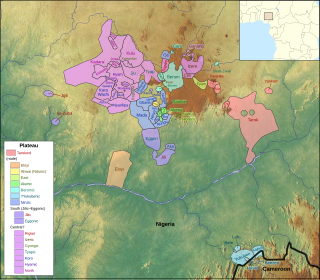
The Afroasiatic languages, also known as Hamito-Semitic or Semito-Hamitic, are a language family of about 400 languages spoken predominantly in West Asia, North Africa, the Horn of Africa, and parts of the Sahara and Sahel. Over 500 million people are native speakers of an Afroasiatic language, constituting the fourth-largest language family after Indo-European, Sino-Tibetan, and Niger–Congo. Most linguists divide the family into six branches: Berber, Chadic, Cushitic, Egyptian, Semitic, and Omotic. The vast majority of Afroasiatic languages are considered indigenous to the African continent, including all those not belonging to the Semitic branch.

The Chadic languages form a branch of the Afroasiatic language family. They are spoken in parts of the Sahel. They include 196 languages spoken across northern Nigeria, southern Niger, southern Chad, and northern Cameroon. By far the most widely spoken Chadic language is Hausa, a lingua franca of much of inland Eastern West Africa, particularly Niger and the northern half of Nigeria.
The Kujargé language is spoken in seven villages in eastern Chad near Jebel Mirra, and in villages scattered along the lower Wadi Salih and Wadi Azum in Darfur, Sudan. It is estimated to have about 1,000 speakers.

The Biu–Mandara or Central Chadic languages of the Afro-Asiatic family are spoken in Nigeria, Chad and Cameroon.

Chad has two official languages, Arabic and French, and over 120 indigenous languages. A vernacular version of Arabic, Chadian Arabic, is a lingua franca and the language of commerce, spoken by 40–60% of the population. The two official languages have fewer speakers than Chadian Arabic. Standard Arabic is spoken by around 615,000 speakers. French is widely spoken in the main cities such as N'Djamena and by most men in the south of the country. Most schooling is in French. The language with the most first-language speakers is probably Ngambay, with around one million speakers.

The forty or so Plateau languages are a tentative group of Benue–Congo languages spoken by 15 million people on the Jos Plateau, Southern Kaduna, Nasarawa State and in adjacent areas in central Nigeria.

Guéra is one of the 23 regions of Chad, created in 2002 from the former Guéra prefecture. The region's capital is Mongo. As of 2009, the population of the region was 553,795.

Tandjilé is one of the 23 regions of Chad, located in the south-west of the country. Its capital is Laï. It corresponds to the former prefecture of the same name.
Marba is an Afro-Asiatic language spoken by the Azumeina peoples of Chad as their first language. It is also the name of one of the Azumeina peoples.
Bidiyo is an Afro-Asiatic language spoken in south central Chad.
Dangaléat is an Afro-Asiatic language spoken in central Chad. Speakers make up the majority of the population of Migami Canton in Mongo, Chad.
Mawa is an Afro-Asiatic language spoken in central Chad.
Mubi is an Afro-Asiatic language spoken in central Chad. It forms one of the Mubi languages, a group of East Chadic languages.
Barein is a Chadic language spoken in south central Chad.
Saba is an Afro-Asiatic language spoken in south central Chad. Speakers are found in Sorki canton in Chinguil sub-prefecture.
Sokoro is an Afro-Asiatic language spoken in central Chad. Dialects are Bedanga and Sokoro. Speakers make up the majority of the population of Gogmi Canton in Melfi, Chad.
Mokilko, or Mukulu, is a Chadic language spoken in central Chad. The local name for the language is Gergiko. This is the name used for mother-tongue literacy materials. Mukulu is the name of a village.
Polci is an Afro-Asiatic language of Bauchi State, Nigeria. It is part of the Barawa cluster, which is in turn part of the West Chadic language family.
Ju is a language from the West Chadian branch of the Chadic language family. The language is spoken solely in Nigeria, and had approximately 900 native speakers in 1993. The language is unwritten.
Tala is a language from the West Chadian branch of the Chadic language family. The language is spoken in the central regions of Nigeria, and had approximately 1000 native speakers in 1993. The language is unwritten.







